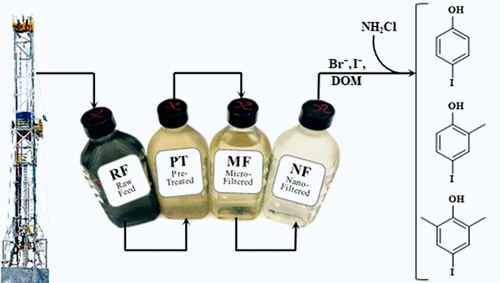当前位置:
X-MOL 学术
›
Environ. Sci. Technol. Lett.
›
论文详情
Our official English website, www.x-mol.net, welcomes your feedback! (Note: you will need to create a separate account there.)
Identification and Comparative Mammalian Cell Cytotoxicity of New Iodo-Phenolic Disinfection Byproducts in Chloraminated Oil and Gas Wastewaters
Environmental Science & Technology Letters ( IF 10.9 ) Pub Date : 2017-11-03 00:00:00 , DOI: 10.1021/acs.estlett.7b00468 Hannah K. Liberatore 1 , Michael J. Plewa 2, 3 , Elizabeth D. Wagner 2, 3 , Jeanne M. VanBriesen 4 , David B. Burnett 5 , Leslie H. Cizmas 6 , Susan D. Richardson 1
Environmental Science & Technology Letters ( IF 10.9 ) Pub Date : 2017-11-03 00:00:00 , DOI: 10.1021/acs.estlett.7b00468 Hannah K. Liberatore 1 , Michael J. Plewa 2, 3 , Elizabeth D. Wagner 2, 3 , Jeanne M. VanBriesen 4 , David B. Burnett 5 , Leslie H. Cizmas 6 , Susan D. Richardson 1
Affiliation

|
Hydraulic fracturing wastewaters discharged to surface water have led to elevated bromide and iodide levels, as well as enhanced formation of brominated trihalomethanes, haloacetic acids, haloacetonitriles, and iodo-trihalomethanes at downstream drinking water treatment plants, in chlorinated effluent from wastewater treatment plants, and in controlled laboratory studies. This enhanced formation of brominated and iodinated disinfection byproducts (DBPs) raises concerns regarding human health, because they are much more toxic than chlorinated DBPs. This study represents the first nontarget, comprehensive analysis of iodinated DBPs formed in chloraminated produced waters associated with hydraulic fracturing of shale and conventional gas formations. Fifty-six iodo-phenolics were identified, comprising three homologous series of mono-, di-, and tri-iodinated phenols, along with two new classes of DBPs: iodomethylphenols and iododimethylphenols. Four iodo-phenolics (2-iodophenol, 4-iodophenol, 2,4,6-triiodophenol, and 4-iodo-2-methylphenol) were investigated for mammalian cell cytotoxicity. All were cytotoxic, especially 2,4,6-triiodophenol, which was more cytotoxic than all trihalomethanes and most haloacetic acids. In addition, geogenic organic compounds present in the oil and gas produced waters, including methylphenol and dimethylphenol, were found to be potential precursors to these iodo-DBPs.
中文翻译:

氯代油气废水中新型碘酚消毒副产物的鉴定和比较哺乳动物细胞的细胞毒性
排放到地表水中的水力压裂废水导致溴化物和碘化物含量升高,并导致下游饮用水处理厂,废水处理厂的氯化废水中溴化三卤甲烷,卤乙酸,卤乙腈和碘代三卤甲烷的形成增加,并且在受控实验室研究中。溴化和碘化消毒副产物(DBP)形成的增加,引起了人们对人体健康的担忧,因为它们比氯化DBP毒性更大。这项研究是对页岩和常规天然气地层水力压裂相关的氯化采出水中形成的碘化DBP的首次非目标性全面分析。确定了56种碘酚,包括三个同源系列的单,双,和三碘化苯酚,以及两类新的DBP:碘甲基苯酚和碘二甲基苯酚。研究了四种碘酚(2-碘酚,4-碘酚,2,4,6-三碘酚和4-碘-2-甲基苯酚)的哺乳动物细胞毒性。全部具有细胞毒性,尤其是2,4,6-三碘苯酚,它比所有三卤代甲烷和大多数卤代乙酸具有更高的细胞毒性。另外,发现在石油和天然气生产的水中存在的地质有机化合物(包括甲基苯酚和二甲基苯酚)是这些碘代DBP的潜在前体。6-三碘苯酚,比所有三卤甲烷和大多数卤代乙酸具有更高的细胞毒性。另外,发现在石油和天然气生产的水中存在的地质有机化合物(包括甲基苯酚和二甲基苯酚)是这些碘代DBP的潜在前体。6-三碘苯酚,比所有三卤甲烷和大多数卤代乙酸具有更高的细胞毒性。另外,发现在石油和天然气生产的水中存在的地质有机化合物(包括甲基苯酚和二甲基苯酚)是这些碘代DBP的潜在前体。
更新日期:2017-11-03
中文翻译:

氯代油气废水中新型碘酚消毒副产物的鉴定和比较哺乳动物细胞的细胞毒性
排放到地表水中的水力压裂废水导致溴化物和碘化物含量升高,并导致下游饮用水处理厂,废水处理厂的氯化废水中溴化三卤甲烷,卤乙酸,卤乙腈和碘代三卤甲烷的形成增加,并且在受控实验室研究中。溴化和碘化消毒副产物(DBP)形成的增加,引起了人们对人体健康的担忧,因为它们比氯化DBP毒性更大。这项研究是对页岩和常规天然气地层水力压裂相关的氯化采出水中形成的碘化DBP的首次非目标性全面分析。确定了56种碘酚,包括三个同源系列的单,双,和三碘化苯酚,以及两类新的DBP:碘甲基苯酚和碘二甲基苯酚。研究了四种碘酚(2-碘酚,4-碘酚,2,4,6-三碘酚和4-碘-2-甲基苯酚)的哺乳动物细胞毒性。全部具有细胞毒性,尤其是2,4,6-三碘苯酚,它比所有三卤代甲烷和大多数卤代乙酸具有更高的细胞毒性。另外,发现在石油和天然气生产的水中存在的地质有机化合物(包括甲基苯酚和二甲基苯酚)是这些碘代DBP的潜在前体。6-三碘苯酚,比所有三卤甲烷和大多数卤代乙酸具有更高的细胞毒性。另外,发现在石油和天然气生产的水中存在的地质有机化合物(包括甲基苯酚和二甲基苯酚)是这些碘代DBP的潜在前体。6-三碘苯酚,比所有三卤甲烷和大多数卤代乙酸具有更高的细胞毒性。另外,发现在石油和天然气生产的水中存在的地质有机化合物(包括甲基苯酚和二甲基苯酚)是这些碘代DBP的潜在前体。


























 京公网安备 11010802027423号
京公网安备 11010802027423号